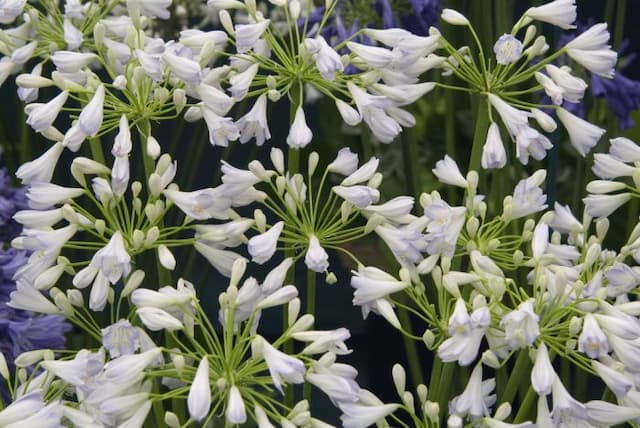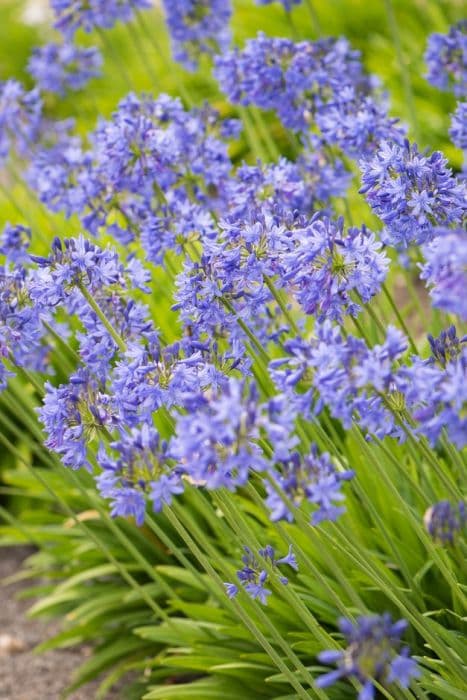African Lily Agapanthus 'Snow Crystal'

ABOUT
The Agapanthus 'Snow Crystal' is characterized by its striking floral display, often referred to by its popular name, the Lily of the Nile, despite not being a true lily. This plant features lush, strap-shaped green leaves that form a dense clump at its base. The leaves create a graceful fountain-like effect that serves as a backdrop for its standout feature, the flowers. The most eye-catching aspect of Snow Crystal is its blooms. They are large, rounded clusters of pure white flowers that resemble delicate stars. These clusters, known as umbels, stand atop sturdy, upright stems that rise from the foliage below. Each individual flower within the umbel is trumpet-shaped and showcases a slight recurve at the petal tips, adding to the overall plush and soft appearance of the bloom cluster. The flowers of the Snow Crystal typically bloom during the summer months, and their snowy white color provides a cool and refreshing contrast in the garden during this warm season. The blossoms are not only beautiful but also attract pollinators such as bees and butterflies, adding to the dynamic life of the garden. Overall, the Agapanthus 'Snow Crystal' presents itself as a graceful and elegant plant, with its smooth leaves and showy clusters of crisp white blooms, offering a serene and inviting appearance.
About this plant
 Names
NamesFamily
Amaryllidaceae.
Synonyms
African Lily, Lily of the Nile, Love Flower.
Common names
Agapanthus africanus 'Snow Crystal'
 Toxicity
ToxicityTo humans
Agapanthus, commonly known as Lily of the Nile, contains substances that are toxic to humans. If ingested, parts of the plant can cause symptoms such as nausea, vomiting, abdominal pain, and diarrhea. In severe cases, the consumption of large amounts can lead to lethargy, tremors, and other neurological symptoms. It's important for humans to avoid eating any part of the Lily of the Nile due to these possible adverse health consequences.
To pets
Lily of the Nile is toxic to pets, including dogs and cats. If pets ingest any part of the plant, they may exhibit symptoms like vomiting, diarrhea, anorexia, and possible lethargy. In some cases, more severe poisoning might lead to tremors or cardiac issues. Care should be taken to prevent pets from consuming Lily of the Nile due to its potential to cause these toxic effects.
 Characteristics
CharacteristicsLife cycle
Perennials
Foliage type
Evergreen
Color of leaves
Green
Flower color
White
Height
2-3 feet (0.6-0.9 meters)
Spread
2-3 feet (0.6-0.9 meters)
Plant type
Bulb
Hardiness zones
8
Native area
South Africa
Benefits
 General Benefits
General Benefits- Ornamental Appeal: Agapanthus 'Snow Crystal', also known as Lily of the Nile, features attractive clusters of white flowers, adding elegance to gardens and landscapes.
- Drought Tolerance: Once established, it is relatively drought-tolerant, making it suitable for water-wise gardens and areas with water restrictions.
- Low Maintenance: It requires minimal care, making it an ideal choice for gardeners looking for low-effort plants.
- Long Blooming Period: The plant has a long flowering season, providing visual interest for much of the summer and into the fall.
- Attracts Pollinators: The blooms attract bees, butterflies, and other pollinating insects, supporting biodiversity.
- Container Gardening: Suitable for container gardening, allowing it to be placed on patios, balconies, and other areas with limited space.
- Deer Resistance: Lily of the Nile is generally resistant to deer, which can be beneficial in areas where deer are a common garden pest.
- Cut Flowers: The long stems and attractive blooms make excellent cut flowers for indoor arrangements.
- Erosion Control: The fibrous root system helps to control erosion on slopes and banks.
- Border Planting: The plant can serve as an effective border or edging plant due to its neat clumping habit.
 Medical Properties
Medical PropertiesThis plant is not used for medical purposes.
 Air-purifying Qualities
Air-purifying QualitiesThis plant is not specifically known for air purifying qualities.
 Other Uses
Other Uses- As a natural dye: The flowers of the Agapanthus 'Snow Crystal' can be used to create a light blue or green dye for fabrics, yarns, or paper.
- In flower arrangements: Due to its striking white blooms, the Snow Crystal can be used as a visually appealing addition to bouquets and floral displays.
- Garden borders: These plants can be used to create vivid borders along garden paths or to demarcate different areas of a landscape.
- Poolside landscaping: The Agapanthus' clumping nature and its tolerance to reflectivity by pools make it suitable for planting near swimming pools.
- Erosion control: The fibrous root system of the Snow Crystal can help stabilize soil on slopes and prevent erosion.
- As a potpourri ingredient: Dried Snow Crystal flowers can be added to potpourri mixes for a subtle, floral scent and for decorative appeal.
- Outdoor living spaces: They are commonly used to enhance the ambiance around patios, decks, and other outdoor seating areas.
- Focal point in the garden: Snow Crystal’s striking appearance can serve as an eye-catching centerpiece in garden designs.
- Seaside gardens: Agapanthus 'Snow Crystal' can tolerate salt spray, making it suitable for gardens near the ocean.
- Edging for water features: These plants can be effectively planted around ponds or fountains to highlight water features in a garden.
Interesting Facts
 Feng Shui
Feng ShuiThe Lily of the Nile is not used in Feng Shui practice.
 Zodiac Sign Compitability
Zodiac Sign CompitabilityThe Lily of the Nile is not used in astrology practice.
 Plant Symbolism
Plant Symbolism- Love Letters: The name "Agapanthus" is derived from the Greek words 'agape' meaning love, and 'anthos' meaning flower, suggesting a form of amorous communication or a declaration of love.
- Beauty: With its striking white blooms, 'Snow Crystal' mirrors the purity and the aesthetic simplicity of snowflakes, sharing a symbolic parallel with beauty and uniqueness.
- Endurance: Agapanthus plants are known for their toughness and ability to survive in harsh conditions, often symbolizing endurance and persistence.
 Water
WaterAfrican Lily should generally be watered once a week, providing the equivalent of 1 inch of rainfall or approximately 0.6 gallons per square foot. Increase water to twice per week during hot, dry periods. For potted plants, water until it runs freely from the drainage holes, making sure the soil is moist but not waterlogged. In winter, reduce watering to every couple of weeks, just enough to prevent the soil from completely drying out.
 Light
LightAfrican Lily thrives best in full sun to partial shade. The ideal spot for this perennial is one where it can receive at least six hours of sunlight daily. If indoors, a south-facing window is an excellent choice to ensure the plant receives ample light.
 Temperature
TemperatureAfrican Lily prefers a temperature range between 50°F and 80°F but can tolerate temperatures as low as 40°F and as high as 100°F for short periods. The ideal growing conditions would be a consistently moderate climate without the risk of frost, which could damage the plant.
 Pruning
PruningPrune African Lily after flowering by removing spent flower stalks to encourage additional blooms and maintain a tidy appearance. It's also advisable to cut back the foliage in late fall to early spring to promote healthy new growth. Pruning should be done annually or as needed when clumps become overcrowded.
 Cleaning
CleaningAs needed
 Soil
SoilAfrican Lily 'Snow Crystal' thrives in a well-draining soil mix comprising two parts loam, one part perlite or sand, and one part compost. The pH should be slightly acidic to neutral, ranging from 6 to 7.
 Repotting
RepottingAfrican Lily 'Snow Crystal' should be repotted every 2 to 3 years to refresh the soil and accommodate root growth.
 Humidity & Misting
Humidity & MistingAfrican Lily 'Snow Crystal' prefers moderate humidity levels but is quite adaptable to different humidity conditions as long as it is not excessively dry.
 Suitable locations
Suitable locationsIndoor
Place in bright, indirect light and water when top soil feels dry.
Outdoor
Plant in partial shade, protect from strong winds, water regularly.
Hardiness zone
8-11 USDA
 Life cycle
Life cycleAgapanthus 'Snow Crystal', commonly known as Lily of the Nile, begins its life cycle as a seed, which after germination develops a set of initial leaves and a primary root. As the plant grows, it forms a clump of linear, strap-shaped leaves and a rhizomatous root system, entering a vegetative stage. Upon maturity, typically in late spring or early summer, it sends up tall, sturdy stalks topped with rounded clusters of white, trumpet-shaped flowers. After the flowering period, the blooms give way to seed capsules if pollination has occurred. In fall or after flowering, the plant enters a dormant phase, where the foliage may die back, especially in cooler climates. With the arrival of warmer weather in spring, the plant breaks dormancy, initiating a new cycle of growth and development.
 Propogation
PropogationPropogation time
Spring-Early Summer
The Agapanthus 'Snow Crystal', commonly known as the African lily or Lily of the Nile, is often propagated through division, which is best done in the spring or early fall. This popular method involves carefully lifting the plant from the ground and using a sharp knife or spade to cut the clump into sections making sure each section has at least one or two growing points or shoots. Once the clump is divided, the sections can be replanted at the same depth they were growing at originally, spacing them about 18 inches (approximately 46 centimeters) apart to allow enough room for growth. Water the newly planted sections well to help establish them. This method is effective because it helps to rejuvenate older clumps that may have become too large or are not blooming as vigorously, stimulating new growth and more prolific flowering.









